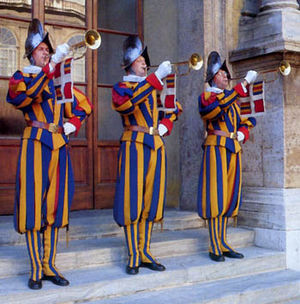Difference between revisions of "Vatican City"
m (format) |
m |
||
| Line 1: | Line 1: | ||
| − | [[Image:Swiss guard.jpg|right|thumb|Swiss | + | [[Image:Swiss guard.jpg|right|thumb|Swiss Guards]] |
[[Image:Ghjhn.jpg|right|thumb|St. Peter's Square.|360px]] | [[Image:Ghjhn.jpg|right|thumb|St. Peter's Square.|360px]] | ||
Revision as of 14:00, June 9, 2007
The State of the Vatican City or simply the Vatican City is an independent state. The head of state and ruler is the Bishop of Rome — the Pope, and the highest state functionaries are all clergymen of the Roman Catholic Church. The Vatican City houses the Government of the Roman Catholic Church and is surrounded by the city of Rome. Until 1871 the Pope held civil power over a considerable territory, called the Papal States. This land was made a part of Italy during the unification of 1871. By the Treaty of the Lateran in 1929, Italy restored the Pope's temporal, or civil, power within the confines of Vatican City, which totals 108.7 acres in area.
The State of the Vatican City has its own Euro coins and postage stamps and postal service. Security is provided by the Pontifical Swiss Guard.
A few critics have pointed out that the Vatican City has one of the highest crime rates in the world.[1] However, this may have something to do with Vatican City's population, which is much smaller than any country, at 778.
The Vatican Cementery
The first popes were buried near the body of St. Peter, in Vatican City... The Cemetery of Priscilla is the oldest general cemetery of Early Christian Rome and in several respects the most important. In this catacomb were buried Sts. Felix and Philip... In the latter half of the fourth century Pope St. Damasus (366-84) did much to beautify the ancient Roman cemeteries and to decorate the tombs of the most illustrious martyrs... After the middle of the ninth century the historic crypts had been emptied, and the bodies brought to Roman churches. Naturally, the written references to the catacombs ceased with the visitors, and a stray chapter in the "Mirabilia Urbis Romae" or an odd indication in the "Libri Indulgentiarum" kept alive the memory of those holy places which once attracted a world of pilgrims. [1]
See also
External links
- Vatican City
- Vatican City Virtual Tours.

